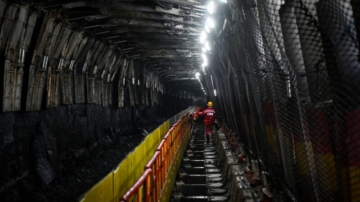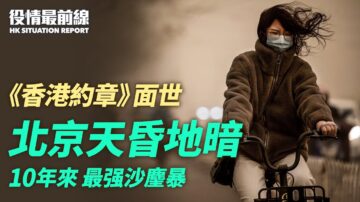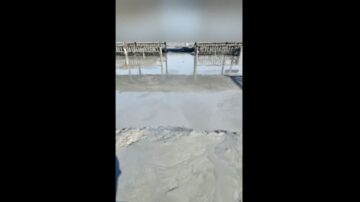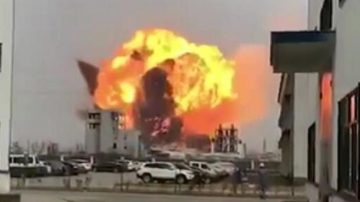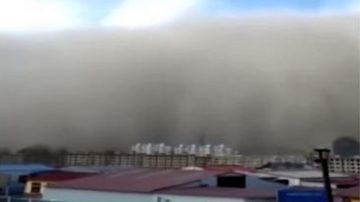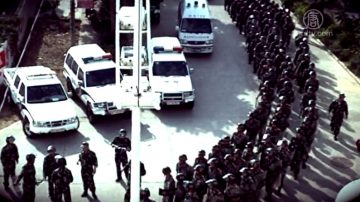【新唐人2013年12月27日讯】中国的雾霾现象越来越严重,扩及的省份也越来越多,老百姓是“霾”怨不断。最近在北京举行的第四次“财新峰会”上,学者指出,治理中国空气污染的帐单将高达2900亿美元。有评论认为,中共投入钜款来治理空气污染,有多少钱会用在治理空气污染上?会不会到头来还是“万亿散尽,污染依然”、“肥了官吏,苦了人民”。
大陆中央气象台25号6点继续发布“霾黄色预警”:预计25号白天,北京南部、河北中南部、天津、山西南部、山东中西部、河南北部、陕西关中、江苏等地,空气污染气象条件5级,局地可达6级,不利于空气中污染物扩散,上述大部地区有中度霾,部分地区有重度霾。25号夜间开始,上述地区的霾将自北向南逐渐消散。
河北省从21号起,已连续发布“霾黄色预警”信号。此外,吉林、山东、江苏等省市也纷纷发布霾预警。在首批公布的74个城市中的PM2.5资料中,有16个城市的空气质量为“严重污染”。空气质量最差的10个城市中,河北省占了6席。其中石家庄、邢台、保定、邯郸“爆表”﹗空气污染指数超过500。
对于雾霾到底是天灾还是人祸这个问题,中国的非政府环保组织最近举行讲座,针对联合国下属的“政府间气候变化专门委员会(IPCC)”发布的最新气候变化报告,进行了讨论。
与会的“中国人民大学”教授王克,谈到中国的碳交易环境时表示:“我们国家现在没有一个总的严格约束的目标。”
据了解,目前中国碳排放总量已经成为世界第一,而欧美则呈下降趋势。
广州财经、社会类评论家 巩胜利:“肯定是人祸,如果是天灾的话,历史上就没有发生过,因为中国五千年来没有发生过,雾霾空气当中含有害颗粒。所以我觉得特别是胡、温时期,可能是致命的要害者,因为他们对发展只要速度是不讲质量。”
中国南方地区从12月开始,也被雾霾袭击,波及25个省、100多个城市。23号,大范围的雾霾天气明显加重,除了河北石家庄、邯郸的空气达到严重污染级别,伸手不见五指外,在四川东部的广安、达川等地城市乡村,也笼罩在弥漫的阴霾中。
而在西安雾霾有多严重?有网友在微博贴出西安着名地标“大雁塔”的对比图,一张10月24号拍摄的照片,“大雁塔”稳稳立在图片中央,塔背后的建筑也清晰可见﹔而在12月18号拍摄的照片中,这座大约有1300年历史的“大雁塔”不见了,只剩下了两排树木。网友戏称,莫非,“大雁塔”被发射了?“全国人民热烈庆祝大雁塔发射成功!”
另外,在交通方面,郑州市交巡警支队指出,电子眼需要同时拍摄到信号灯和车辆号牌,两者缺一不可。如果雾霾严重到连人眼都不能识别信号灯,那么电子眼肯定也识别不了。
在北京举行的第四次“财新峰会”上,与会中国学者表示,治理中国空气污染的帐单将高达2900亿美元。
浙江杭州环保维权人士 陈法庆:“国家投入这么大钜额的资金来治理环境污染,当然受伤害的还是中国13亿的老百姓,我们连呼吸的空气都这么污染了,你看那些媒体还说,我们的空气比较好,没有雾霾,主要是中央的高层对这个重视不够,也就是说,是呼吁的多,做的少,主要的根源在这里。”
对于世界任何城市而言,上千亿美元的投资都是一笔天文数字,然而这笔庞大的投资是否真的有效果,可以让中国的居民出门不再需要戴口罩?还是需要时间来证明﹗不过眼前的这笔钜额,民众恐怕是得先买单了。
采访/朱智善 编辑/黄亿美 后制/孙宁
Who will pay for the $290 billion smog treatment?
The smog has grown more and more severe and has spread,
causing a serious issue for the Chinese.
At the 4th Caixin Summit, experts reported that controlling
air pollution will cost $290 billion.
People question such a high figure.
They wonder whether the money will go towards improving
the air quality or simply line the officials' pockets.
The Chinese National Meteorological Center (NMC) issued
a yellow - meaning mid to heavy – smog warning on Dec. 25
for the smog covering Beijing, Tianjin, and cities of Hebei,
Shanxi, Shandong, Henan, Shaanxi, Guanzhong and Jiangsu.
The smog will dissipate gradually from north to south
in the evening, the NMC informed.
Since Dec. 21, a yellow warning has been issued for Hebei.
In addition, Jilin, Shandong, and Jiangsu have also issued
haze warnings.
According to the PM2.5, the index that measures particle
matter, 16 out of 74 cities have heavily polluted air.
Among the 10 worst cities, six are located in Hebei,
and four - Shijiazhuang, Xingtai, Baoding, and Handan -
had PM2.5 measurements over 500.
Environmental NGO's in China recently held talks
regarding whether smog is a natural disaster or is man-made.
They discussed the latest report from the UN
Intergovernmental Panel on Climate Change (IPCC).
Wang Ke, professor at Renmin University in China,
indicated that "China does not have an overall restriction goal"
regarding carbon reduction.
It is understood that China's carbon footprint
is unprecedented.
Meanwhile, the Western world has taken steps
to reduce theirs.
Gong Shengli, commentator: "It is certainly man-made.
In the five thousand years of Chinese history,
there has never been smog.
There are toxic particles in the smog, surely it is man-made.
I believe that Hu and Wen are the main culprits, because
they developed the economy at the risk of the quality."
Since December, smog has affected Southern China,
covering 25 provinces and more than 100 cities.
On Dec. 23, a wide range of thick smog affected
Shijiazhuang and Handan of Hebei province,
and also shrouded the eastern portion of Sichuan.
The severity of smog in Xi'an is also revealed in netizens'
online photos.
Famous Xi'an landmark Giant Wild Goose Pagoda
was shown in two photos taken on Oct. 24 and Dec. 18.
In the Oct. 24 photo, the Pagoda firmly stands center
and the background is clear.
In the Dec. 18 photo, this 1,300 year-old historical building
had disappeared; only the tree lines were visible.
Netizens ridiculed, "Has the Pagoda been launched
(into flight)?"
"The whole nation celebrates the successful launch
of the Pagoda!"
In addition, according to Zhengzhou City Traffic Patrol,
traffic cameras need to detect both traffic lights
and vehicle license plates for traffic control purposes.
However, if the smog is so heavy that human eyes can't see
the signals, the cameras won't be able to detect signals either.
At the 4th Caixin Summit, participants indicated that it will
cost $290 billion to improve China's air quality.
Chen Faqing, Hangzhou environmentalist: "With such
a large investment in environmental pollution, of course
the 1.3 billion Chinese will bear the cost.
The air we breath has been so polluted but the media still
claims the air is good and is without pollution.
The Central officials don't care about this.
That's the main issue - more talk than action."
Billions of dollars is an astronomical sum for any city
in the world to invest.
As for whether this investment will truly improve
the air quality, only time will tell.
It is such an enormous sum and the masses
of Chinese have to foot the bill.
Interview/ZhuZhishan Edit/HuangYimei Post-Production/SunNing
大陆中央气象台25号6点继续发布“霾黄色预警”:预计25号白天,北京南部、河北中南部、天津、山西南部、山东中西部、河南北部、陕西关中、江苏等地,空气污染气象条件5级,局地可达6级,不利于空气中污染物扩散,上述大部地区有中度霾,部分地区有重度霾。25号夜间开始,上述地区的霾将自北向南逐渐消散。
河北省从21号起,已连续发布“霾黄色预警”信号。此外,吉林、山东、江苏等省市也纷纷发布霾预警。在首批公布的74个城市中的PM2.5资料中,有16个城市的空气质量为“严重污染”。空气质量最差的10个城市中,河北省占了6席。其中石家庄、邢台、保定、邯郸“爆表”﹗空气污染指数超过500。
对于雾霾到底是天灾还是人祸这个问题,中国的非政府环保组织最近举行讲座,针对联合国下属的“政府间气候变化专门委员会(IPCC)”发布的最新气候变化报告,进行了讨论。
与会的“中国人民大学”教授王克,谈到中国的碳交易环境时表示:“我们国家现在没有一个总的严格约束的目标。”
据了解,目前中国碳排放总量已经成为世界第一,而欧美则呈下降趋势。
广州财经、社会类评论家 巩胜利:“肯定是人祸,如果是天灾的话,历史上就没有发生过,因为中国五千年来没有发生过,雾霾空气当中含有害颗粒。所以我觉得特别是胡、温时期,可能是致命的要害者,因为他们对发展只要速度是不讲质量。”
中国南方地区从12月开始,也被雾霾袭击,波及25个省、100多个城市。23号,大范围的雾霾天气明显加重,除了河北石家庄、邯郸的空气达到严重污染级别,伸手不见五指外,在四川东部的广安、达川等地城市乡村,也笼罩在弥漫的阴霾中。
而在西安雾霾有多严重?有网友在微博贴出西安着名地标“大雁塔”的对比图,一张10月24号拍摄的照片,“大雁塔”稳稳立在图片中央,塔背后的建筑也清晰可见﹔而在12月18号拍摄的照片中,这座大约有1300年历史的“大雁塔”不见了,只剩下了两排树木。网友戏称,莫非,“大雁塔”被发射了?“全国人民热烈庆祝大雁塔发射成功!”
另外,在交通方面,郑州市交巡警支队指出,电子眼需要同时拍摄到信号灯和车辆号牌,两者缺一不可。如果雾霾严重到连人眼都不能识别信号灯,那么电子眼肯定也识别不了。
在北京举行的第四次“财新峰会”上,与会中国学者表示,治理中国空气污染的帐单将高达2900亿美元。
浙江杭州环保维权人士 陈法庆:“国家投入这么大钜额的资金来治理环境污染,当然受伤害的还是中国13亿的老百姓,我们连呼吸的空气都这么污染了,你看那些媒体还说,我们的空气比较好,没有雾霾,主要是中央的高层对这个重视不够,也就是说,是呼吁的多,做的少,主要的根源在这里。”
对于世界任何城市而言,上千亿美元的投资都是一笔天文数字,然而这笔庞大的投资是否真的有效果,可以让中国的居民出门不再需要戴口罩?还是需要时间来证明﹗不过眼前的这笔钜额,民众恐怕是得先买单了。
采访/朱智善 编辑/黄亿美 后制/孙宁
Who will pay for the $290 billion smog treatment?
The smog has grown more and more severe and has spread,
causing a serious issue for the Chinese.
At the 4th Caixin Summit, experts reported that controlling
air pollution will cost $290 billion.
People question such a high figure.
They wonder whether the money will go towards improving
the air quality or simply line the officials' pockets.
The Chinese National Meteorological Center (NMC) issued
a yellow - meaning mid to heavy – smog warning on Dec. 25
for the smog covering Beijing, Tianjin, and cities of Hebei,
Shanxi, Shandong, Henan, Shaanxi, Guanzhong and Jiangsu.
The smog will dissipate gradually from north to south
in the evening, the NMC informed.
Since Dec. 21, a yellow warning has been issued for Hebei.
In addition, Jilin, Shandong, and Jiangsu have also issued
haze warnings.
According to the PM2.5, the index that measures particle
matter, 16 out of 74 cities have heavily polluted air.
Among the 10 worst cities, six are located in Hebei,
and four - Shijiazhuang, Xingtai, Baoding, and Handan -
had PM2.5 measurements over 500.
Environmental NGO's in China recently held talks
regarding whether smog is a natural disaster or is man-made.
They discussed the latest report from the UN
Intergovernmental Panel on Climate Change (IPCC).
Wang Ke, professor at Renmin University in China,
indicated that "China does not have an overall restriction goal"
regarding carbon reduction.
It is understood that China's carbon footprint
is unprecedented.
Meanwhile, the Western world has taken steps
to reduce theirs.
Gong Shengli, commentator: "It is certainly man-made.
In the five thousand years of Chinese history,
there has never been smog.
There are toxic particles in the smog, surely it is man-made.
I believe that Hu and Wen are the main culprits, because
they developed the economy at the risk of the quality."
Since December, smog has affected Southern China,
covering 25 provinces and more than 100 cities.
On Dec. 23, a wide range of thick smog affected
Shijiazhuang and Handan of Hebei province,
and also shrouded the eastern portion of Sichuan.
The severity of smog in Xi'an is also revealed in netizens'
online photos.
Famous Xi'an landmark Giant Wild Goose Pagoda
was shown in two photos taken on Oct. 24 and Dec. 18.
In the Oct. 24 photo, the Pagoda firmly stands center
and the background is clear.
In the Dec. 18 photo, this 1,300 year-old historical building
had disappeared; only the tree lines were visible.
Netizens ridiculed, "Has the Pagoda been launched
(into flight)?"
"The whole nation celebrates the successful launch
of the Pagoda!"
In addition, according to Zhengzhou City Traffic Patrol,
traffic cameras need to detect both traffic lights
and vehicle license plates for traffic control purposes.
However, if the smog is so heavy that human eyes can't see
the signals, the cameras won't be able to detect signals either.
At the 4th Caixin Summit, participants indicated that it will
cost $290 billion to improve China's air quality.
Chen Faqing, Hangzhou environmentalist: "With such
a large investment in environmental pollution, of course
the 1.3 billion Chinese will bear the cost.
The air we breath has been so polluted but the media still
claims the air is good and is without pollution.
The Central officials don't care about this.
That's the main issue - more talk than action."
Billions of dollars is an astronomical sum for any city
in the world to invest.
As for whether this investment will truly improve
the air quality, only time will tell.
It is such an enormous sum and the masses
of Chinese have to foot the bill.
Interview/ZhuZhishan Edit/HuangYimei Post-Production/SunNing

